1. Katz J, Jackson M, Kavanagh BP, Sandler AN. Acute pain after thoracic surgery predicts long-term post-thoracotomy pain. Clin J Pain. 1996; 12:50–55. PMID:
8722735.

2. Perttunen K, Tasmuth T, Kalso E. Chronic pain after thoracic surgery: a follow-up study. Acta Anaesthesiol Scand. 1999; 43:563–567. PMID:
10342006.

3. Poleshuck EL, Katz J, Andrus CH, Hogan LA, Jung BF, Kulick DI, Dworkin RH. Risk factors for chronic pain following breast cancer surgery: a prospective study. J Pain. 2006; 7:626–634. PMID:
16942948.

4. Subramaniam B, Pawar DK, Kashyap L. Pre-emptive analgesia with epidural morphine or morphine and bupivacaine. Anaesth Intensive Care. 2000; 28:392–398. PMID:
10969365.

5. Yegin A, Erdogan A, Kayacan N, Karsli B. Early postoperative pain management after thoracic surgery; pre- and postoperative versus postoperative epidural analgesia: a randomised study. Eur J Cardiothorac Surg. 2003; 24:420–424. PMID:
12965314.

6. Troncy E, Junot S, Keroack S, Sammut V, Pibarot P, Genevois JP, Cuvelliez S. Results of preemptive epidural administration of morphine with or without bupivacaine in dogs and cats undergoing surgery: 265 cases (1997-1999). J Am Vet Med Assoc. 2002; 221:666–672. PMID:
12216906.

7. Batista LM, Batista IM, Almeida JP, Carvalho CH, Castro-Costa SB, Castro-Costa CM. Preemptive analgesic effect of lidocaine in a chronic neuropathic pain model. Arq Neuropsiquiatr. 2009; 67:1088–1092. PMID:
20069225.

8. Binshtok AM, Bean BP, Woolf CJ. Inhibition of nociceptors by TRPV1-mediated entry of impermeant sodium channel blockers. Nature. 2007; 449:607–610. PMID:
17914397.

9. Kim HY, Kim K, Li HY, Chung G, Park CK, Kim JS, Jung SJ, Lee MK, Ahn DK, Hwang SJ, Kang Y, Binshtok AM, Bean BP, Woolf CJ, Oh SB. Selectively targeting pain in the trigeminal system. Pain. 2010; 150:29–40. PMID:
20236764.

10. Sagie I, Kohane DS. Prolonged sensory-selective nerve blockade. Proc Natl Acad Sci U S A. 2010; 107:3740–3745. PMID:
20133669.

11. Gerner P, Binshtok AM, Wang CF, Hevelone ND, Bean BP, Woolf CJ, Wang GK. Capsaicin combined with local anesthetics preferentially prolongs sensory/nociceptive block in rat sciatic nerve. Anesthesiology. 2008; 109:872–878. PMID:
18946300.

12. Ries CR, Pillai R, Chung CC, Wang JT, MacLeod BA, Schwarz SK. QX-314 produces long-lasting local anesthesia modulated by transient receptor potential vanilloid receptors in mice. Anesthesiology. 2009; 111:122–126. PMID:
19512885.

13. Baker MD, Wood JN. Involvement of Na
+ channels in pain pathways. Trends Pharmacol Sci. 2001; 22:27–31. PMID:
11165669.
14. Dib-Hajj SD, Black JA, Waxman SG. Voltage-gated sodium channels: therapeutic targets for pain. Pain Med. 2009; 10:1260–1269. PMID:
19818036.

15. Imamura Y, Kawamoto H, Nakanishi O. Characterization of heat-hyperalgesia in an experimental trigeminal neuropathy in rats. Exp Brain Res. 1997; 116:97–103. PMID:
9305818.

16. Lim EJ, Jeon HJ, Yang GY, Lee MK, Ju JS, Han SR, Ahn DK. Intracisternal administration of mitogen-activated protein kinase inhibitors reduced mechanical allodynia following chronic constriction injury of infraorbital nerve in rats. Prog Neuropsychopharmacol Biol Psychiatry. 2007; 31:1322–1329. PMID:
17618720.

17. Ahn DK, Lee SY, Han SR, Ju JS, Yang GY, Lee MK, Youn DH, Bae YC. Intratrigeminal ganglionic injection of LPA causes neuropathic pain-like behavior and demyelination in rats. Pain. 2009; 146:114–120. PMID:
19665300.

18. Ahn DK, Lim EJ, Kim BC, Yang GY, Lee MK, Ju JS, Han SR, Bae YC. Compression of the trigeminal ganglion produces prolonged nociceptive behavior in rats. Eur J Pain. 2009; 13:568–575. PMID:
18774318.

19. Kim MJ, Park YH, Yang KY, Ju JS, Bae YC, Han SK, Ahn DK. Participation of central GABAA receptors in the trigeminal processing of mechanical allodynia in rats. Korean J Physiol Pharmacol. 2017; 21:65–74. PMID:
28066142.
20. Kim MJ, Shin HJ, Won KA, Yang KY, Ju JS, Park YY, Park JS, Bae YC, Ahn DK. Progesterone produces antinociceptive and neuroprotective effects in rats with microinjected lysophosphatidic acid in the trigeminal nerve root. Mol Pain. 2012; 8:16. PMID:
22429647.

21. Han SR, Yang GY, Ahn MH, Kim MJ, Ju JS, Bae YC, Ahn DK. Blockade of microglial activation reduces mechanical allodynia in rats with compression of the trigeminal ganglion. Prog Neuropsychopharmacol Biol Psychiatry. 2012; 36:52–59. PMID:
22019843.

22. Jeon HJ, Han SR, Lim KH, Won KA, Bae YC, Ahn DK. Intracisternal administration of NR2 subunit antagonists attenuates the nociceptive behavior and p-p38 MAPK expression produced by compression of the trigeminal nerve root. Mol Pain. 2011; 7:46. PMID:
21651766.

23. Jeon HJ, Han SR, Park MK, Yang KY, Bae YC, Ahn DK. A novel trigeminal neuropathic pain model: compression of the trigeminal nerve root produces prolonged nociception in rats. Prog Neuropsychopharmacol Biol Psychiatry. 2012; 38:149–158. PMID:
22449477.

24. Yang KY, Kim MJ, Ju JS, Park SK, Lee CG, Kim ST, Bae YC, Ahn DK. Antinociceptive effects of botulinum toxin type A on trigeminal neuropathic pain. J Dent Res. 2016; 95:1183–1190. PMID:
27418174.

25. Cho YS, Ryu CH, Won JH, Vang H, Oh SB, Ro JY, Bae YC. Rat odontoblasts may use glutamate to signal dentin injury. Neuroscience. 2016; 335:54–63. PMID:
27555550.

26. Ahn DK, Chae JM, Choi HS, Kyung HM, Kwon OW, Park HS, Youn DH, Bae YC. Central cyclooxygenase inhibitors reduced IL-1betainduced hyperalgesia in temporomandibular joint of freely moving rats. Pain. 2005; 117:204–213. PMID:
16098663.
27. Harada M, Takeuchi M, Fukao T, Katagiri K. A simple method for the quantitative extraction of dye extravasated into the skin. J Pharm Pharmacol. 1971; 23:218–219. PMID:
4396896.

28. Trabulsi EJ, Patel J, Viscusi ER, Gomella LG, Lallas CD. Preemptive multimodal pain regimen reduces opioid analgesia for patients undergoing robotic-assisted laparoscopic radical prostatectomy. Urology. 2010; 76:1122–1124. PMID:
20570321.

29. Ryu HG, Lee CJ, Kim YT, Bahk JH. Preemptive low-dose epidural ketamine for preventing chronic postthoracotomy pain: a prospective, double-blinded, randomized, clinical trial. Clin J Pain. 2011; 27:304–308. PMID:
21178605.
30. Pandit MK, Godhi S, Lall AB. Preoperative intravenous tramadol versus diclofenac for preventing postoperative pain after third molar surgery: a comparative study. J Maxillofac Oral Surg. 2011; 10:306–309. PMID:
23204745.

31. Shah R, Mahajan A, Shah N, Dadhania AP. Preemptive analgesia in third molar impaction surgery. Natl J Maxillofac Surg. 2012; 3:144–147. PMID:
23833488.

32. Rooney BA, Crown ED, Hulsebosch CE, McAdoo DJ. Preemptive analgesia with lidocaine prevents Failed Back Surgery Syndrome. Exp Neurol. 2007; 204:589–596. PMID:
17261281.

33. Lee IH, Lee IO. Preemptive effect of intravenous ketamine in the rat: concordance between pain behavior and spinal fos-like immunoreactivity. Acta Anaesthesiol Scan. 2005; 49:160–165.

34. Hasani AS, Soljakova M, Jakupi MH, Ustalar-Ozgen SZ. Preemptive analgesic effect of diclofenac: experimental study in rats. Middle East J Anaesthesiol. 2011; 21:355–360. PMID:
22428489.
35. Aguilar JL, Rincón R, Domingo V, Espachs P, Preciado MJ, Vidal F. Absence of an early pre-emptive effect after thoracic extradural bupivacaine in thoracic surgery. Br J Anaesth. 1996; 76:72–76. PMID:
8672384.

36. Chang WK, Tao YX, Chuang CC, Chen PT, Chan KH, Chu YC. Lack of beneficial effect for preemptive analgesia in postoperative pain control: verifying the efficacy of preemptive analgesia with N-methyl-D-aspartate receptor antagonists in a modified animal model of postoperative pain. Anesth Analg. 2011; 112:710–718. PMID:
21233503.
37. Seetharaman SV, Prudencio M, Karch C, Holloway SP, Borchelt DR, Hart PJ. Immature copper-zinc superoxide dismutase and familial amyotrophic lateral sclerosis. Exp Biol Med (Maywood). 2009; 234:1140–1154. PMID:
19596823.

38. Caterina MJ, Schumacher MA, Tominaga M, Rosen TA, Levine JD, Julius D. The capsaicin receptor: a heat-activated ion channel in the pain pathway. Nature. 1997; 389:816–824. PMID:
9349813.

39. Jhaveri MD, Elmes SJ, Kendall DA, Chapman V. Inhibition of peripheral vanilloid TRPV1 receptors reduces noxious heat-evoked responses of dorsal horn neurons in naïve, carrageenan-inflamed and neuropathic rats. Eur J Neurosci. 2005; 22:361–370. PMID:
16045489.

40. Hanani M. Satellite glial cells in sensory ganglia: from form to function. Brain Res Brain Res Rev. 2005; 48:457–476. PMID:
15914252.

41. Cherkas PS, Huang TY, Pannicke T, Tal M, Reichenbach A, Hanani M. The effects of axotomy on neurons and satellite glial cells in mouse trigeminal ganglion. Pain. 2004; 110:290–298. PMID:
15275779.

42. Donegan M, Kernisant M, Cua C, Jasmin L, Ohara PT. Satellite glial cell proliferation in the trigeminal ganglia after chronic constriction injury of the infraorbital nerve. Glia. 2013; 61:2000–2008. PMID:
24123473.

43. Stephenson JL, Byers MR. GFAP immunoreactivity in trigeminal ganglion satellite cells after tooth injury in rats. Exp Neurol. 1995; 131:11–22. PMID:
7895805.

44. Jin SX, Zhuang ZY, Woolf CJ, Ji RR. p38 mitogen-activated protein kinase is activated after a spinal nerve ligation in spinal cord microglia and dorsal root ganglion neurons and contributes to the generation of neuropathic pain. J Neurosci. 2003; 23:4017–4022. PMID:
12764087.

45. Schäfers M, Svensson CI, Sommer C, Sorkin LS. Tumor necrosis factor-alpha induces mechanical allodynia after spinal nerve ligation by activation of p38 MAPK in primary sensory neurons. J Neurosci. 2003; 23:2517–2521. PMID:
12684435.
46. Obata K, Yamanaka H, Dai Y, Mizushima T, Fukuoka T, Tokunaga A, Noguchi K. Differential activation of MAPK in injured and uninjured DRG neurons following chronic constriction injury of the sciatic nerve in rats. Eur J Neurosci. 2004; 20:2881–2895. PMID:
15579142.

47. Komiya H, Shimizu K, Noma N, Tsuboi Y, Honda K, Kanno K, Ohara K, Shinoda M, Ogiso B, Iwata K. Role of neuron-glial interaction mediated by IL-1β in ectopic tooth pain. J Dent Res. 2018; 97:467–475. PMID:
29131694.

48. Kobayashi A, Shinoda M, Sessle BJ, Honda K, Imamura Y, Hitomi S, Tsuboi Y, Okada-Ogawa A, Iwata K. Mechanism involed in extraterritorial facial pain following cervical spinal nerve injury in rats. Mol Pain. 2011; 7:12. PMID:
21310020.
49. Iwata K, Katagiri A, Shinoda M. Neuron-glia interaction is a key mechanism underlying persistent orofacial pain. J Oral Sci. 2017; 59:173–175. PMID:
28637974.

50. Wu XB, Cao DL, Zhang X, Jiang BC, Zhao LX, Qian B, Gao YJ. CXCL13/CXCR5 enhances sodium channel Nav1.8 current density via p38 MAP kinase in primary sensory neurons following inflammatory pain. Sci Rep. 2016; 6:34836. PMID:
27708397.

51. Gudes S, Barkai O, Caspi Y, Katz B, Lev S, Binshtok AM. The role of slow and persistent TTX-resistant sodium currents in acute tumor necrosis factor-α-mediated increase in nociceptors excitability. J Neurophysiol. 2015; 113:601–619. PMID:
25355965.

52. Marban E, Yamagishi T, Tomaselli GF. Structure and function of voltage-gated sodium channels. J Physiol. 1998; 508:647–657. PMID:
9518722.

53. Catterall WA, Goldin AL, Waxman SG. International Union of Pharmacology. XLVII. Nomenclature and structure-function relationships of voltage-gated sodium channels. Pharmacol Rev. 2005; 57:397–409. PMID:
16382098.

54. Samad OA, Tan AM, Cheng X, Foster E, Dib-Hajj SD, Waxman SG. Virus-mediated shRNA knockdown of Na(v)1.3 in rat dorsal root ganglion attenuates nerve injury-induced neuropathic pain. Mol Ther. 2013; 21:49–56. PMID:
22910296.

55. Huang J, Han C, Estacion M, Vasylyev D, Hoeijmakers JG, Gerrits MM, Tyrrell L, Lauria G, Faber CG, Dib-Hajj SD, Merkies IS, Waxman SG. PROPANE Study Group. Gain-of-function mutations in sodium channel Na(v)1.9 in painful neuropathy. Brain. 2014; 137:1627–1642. PMID:
24776970.

56. Liu C, Cao J, Ren X, Zang W. Nav1.7 protein and mRNA expression in the dorsal root ganglia of rats with chronic neuropathic pain. Neural Regen Res. 2012; 7:1540–1544. PMID:
25657691.
57. Watanabe K, Larsson K, Rydevik B, Konno S, Nordborg C, Olmarker K. Increase of sodium channels (nav 1.8 and nav 1.9) in rat dorsal root ganglion neurons exposed to autologous nucleus pulposus. Open Orthop J. 2014; 8:69–73. PMID:
24843387.
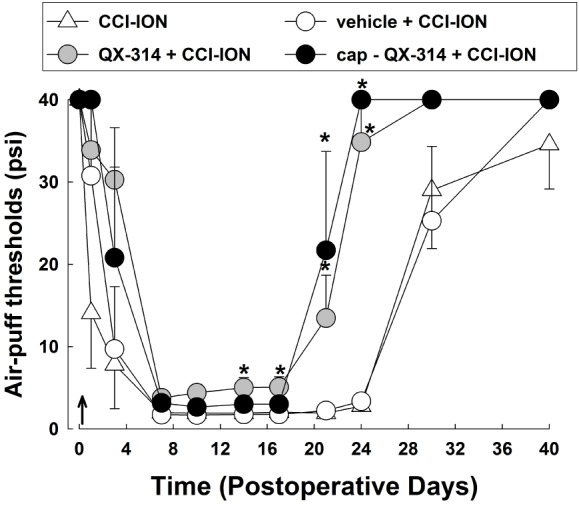
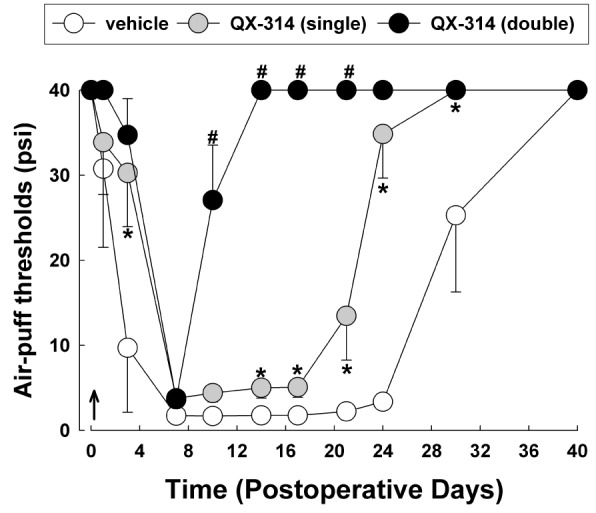
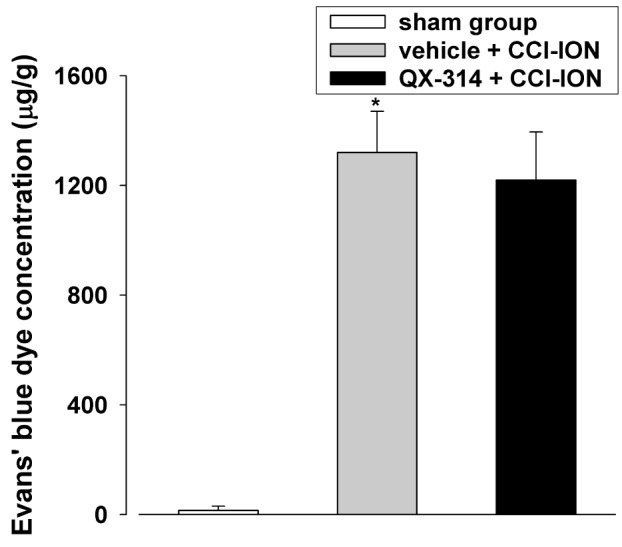


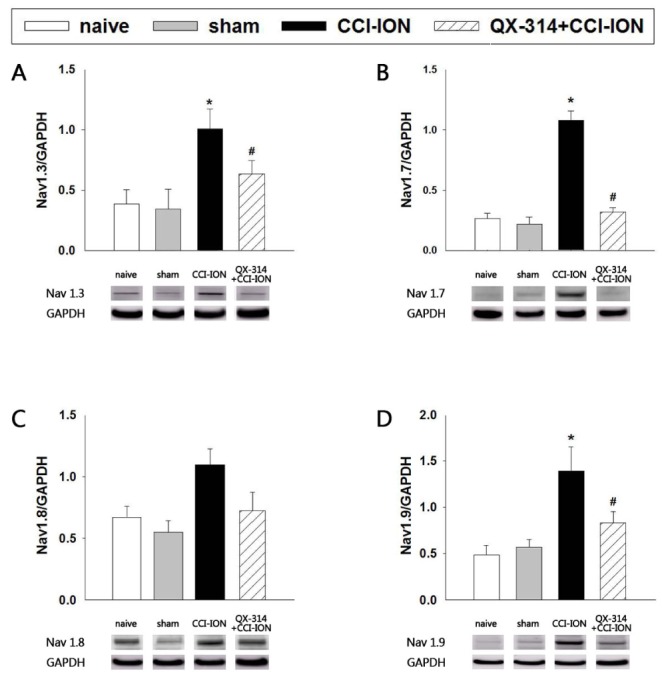




 PDF
PDF ePub
ePub Citation
Citation Print
Print


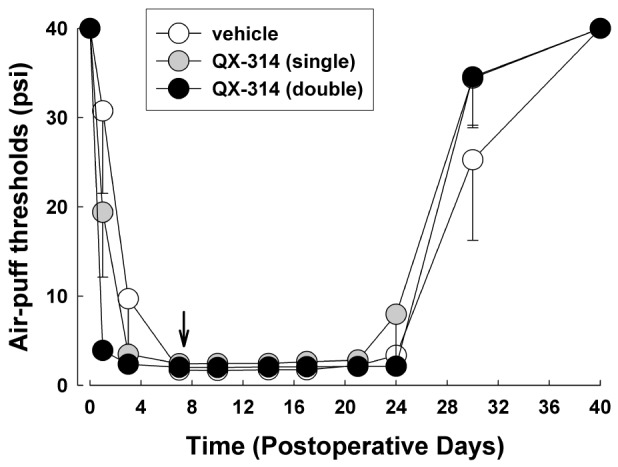
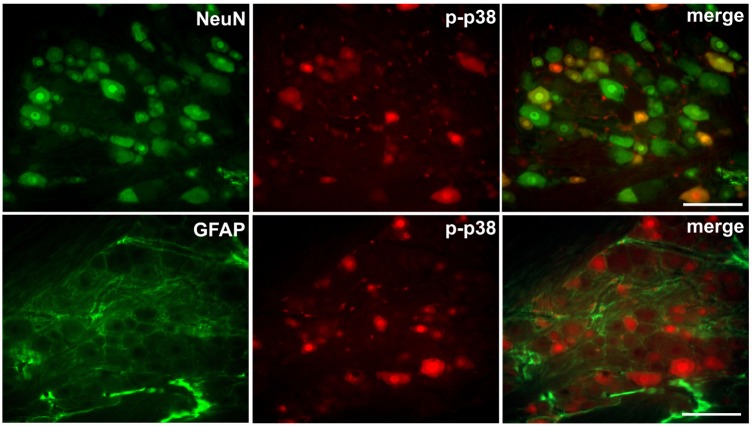
 XML Download
XML Download